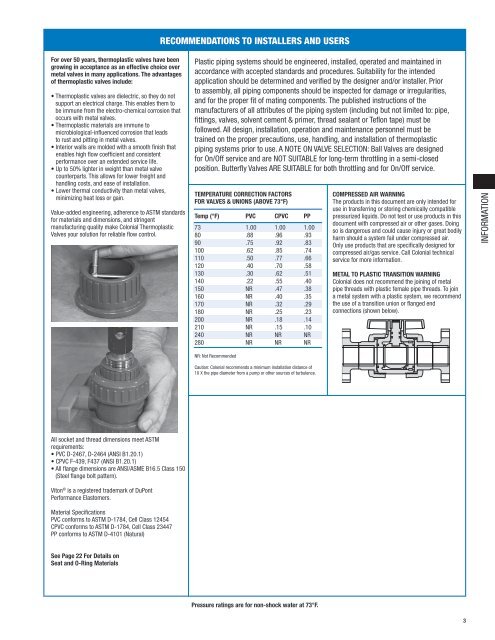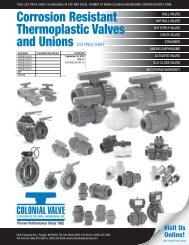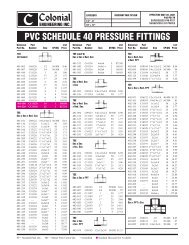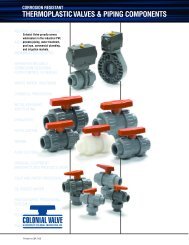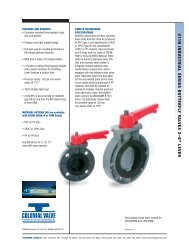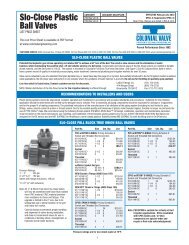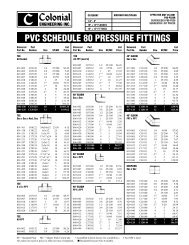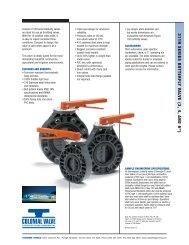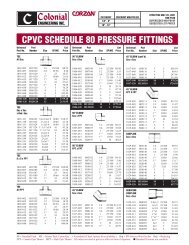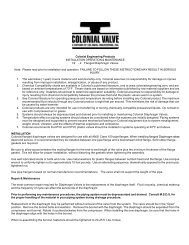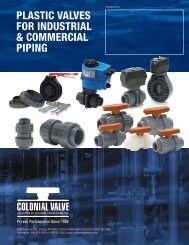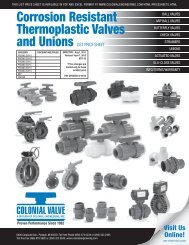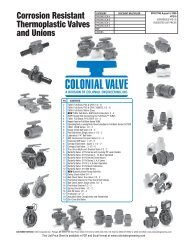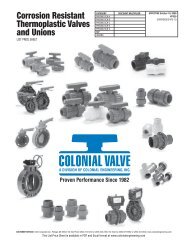Low Resolution PDF - Colonial Engineering
Low Resolution PDF - Colonial Engineering
Low Resolution PDF - Colonial Engineering
Create successful ePaper yourself
Turn your PDF publications into a flip-book with our unique Google optimized e-Paper software.
RECOMMENDATIONS TO INSTALLERS AND USERS<br />
For over 50 years, thermoplastic valves have been<br />
growing in acceptance as an effective choice over<br />
metal valves in many applications. The advantages<br />
of thermoplastic valves include:<br />
• Thermoplastic valves are dielectric, so they do not<br />
support an electrical charge. This enables them to<br />
be immune from the electro-chemical corrosion that<br />
occurs with metal valves.<br />
• Thermoplastic materials are immune to<br />
microbiological-influenced corrosion that leads<br />
to rust and pitting in metal valves.<br />
• Interior walls are molded with a smooth finish that<br />
enables high flow coefficient and consistent<br />
performance over an extended service life.<br />
• Up to 50% lighter in weight than metal valve<br />
counterparts. This allows for lower freight and<br />
handling costs, and ease of installation.<br />
• <strong>Low</strong>er thermal conductivity than metal valves,<br />
minimizing heat loss or gain.<br />
Value-added engineering, adherence to ASTM standards<br />
for materials and dimensions, and stringent<br />
manufacturing quality make <strong>Colonial</strong> Thermoplastic<br />
Valves your solution for reliable flow control.<br />
Plastic piping systems should be engineered, installed, operated and maintained in<br />
accordance with accepted standards and procedures. Suitability for the intended<br />
application should be determined and verified by the designer and/or installer. Prior<br />
to assembly, all piping components should be inspected for damage or irregularities,<br />
and for the proper fit of mating components. The published instructions of the<br />
manufacturers of all attributes of the piping system (including but not limited to: pipe,<br />
fittings, valves, solvent cement & primer, thread sealant or Teflon tape) must be<br />
followed. All design, installation, operation and maintenance personnel must be<br />
trained on the proper precautions, use, handling, and installation of thermoplastic<br />
piping systems prior to use. A NOTE ON VALVE SELECTION: Ball Valves are designed<br />
for On/Off service and are NOT SUITABLE for long-term throttling in a semi-closed<br />
position. Butterfly Valves ARE SUITABLE for both throttling and for On/Off service.<br />
TEMPERATURE CORRECTION FACTORS<br />
FOR VALVES & UNIONS (ABOVE 73°F)<br />
Temp (°F) PVC CPVC PP<br />
73 1.00 1.00 1.00<br />
80 .88 .96 .93<br />
90 .75 .92 .83<br />
100 .62 .85 .74<br />
110 .50 .77 .66<br />
120 .40 .70 .58<br />
130 .30 .62 .51<br />
140 .22 .55 .40<br />
150 NR .47 .38<br />
160 NR .40 .35<br />
170 NR .32 .29<br />
180 NR .25 .23<br />
200 NR .18 .14<br />
210 NR .15 .10<br />
240 NR NR NR<br />
280 NR NR NR<br />
NR: Not Recommended<br />
Caution: <strong>Colonial</strong> recommends a minimum installation distance of<br />
10 X the pipe diameter from a pump or other sources of turbulence.<br />
COMPRESSED AIR WARNING<br />
The products in this document are only intended for<br />
use in transferring or storing chemically compatible<br />
pressurized liquids. Do not test or use products in this<br />
document with compressed air or other gases. Doing<br />
so is dangerous and could cause injury or great bodily<br />
harm should a system fail under compressed air.<br />
Only use products that are specifically designed for<br />
compressed air/gas service. Call <strong>Colonial</strong> technical<br />
service for more information.<br />
METAL TO PLASTIC TRANSITION WARNING<br />
<strong>Colonial</strong> does not recommend the joining of metal<br />
pipe threads with plastic female pipe threads. To join<br />
a metal system with a plastic system, we recommend<br />
the use of a transition union or flanged end<br />
connections (shown below).<br />
INFORMATION<br />
All socket and thread dimensions meet ASTM<br />
requirements:<br />
• PVC D-2467, D-2464 (ANSI B1.20.1)<br />
• CPVC F-439, F437 (ANSI B1.20.1)<br />
• All flange dimensions are ANSI/ASME B16.5 Class 150<br />
(Steel flange bolt pattern).<br />
Viton ® is a registered trademark of DuPont<br />
Performance Elastomers.<br />
Material Specifications<br />
PVC conforms to ASTM D-1784, Cell Class 12454<br />
CPVC conforms to ASTM D-1784, Cell Class 23447<br />
PP conforms to ASTM D-4101 (Natural)<br />
See Page 22 For Details on<br />
Seat and O-Ring Materials<br />
Pressure ratings are for non-shock water at 73°F.<br />
3


